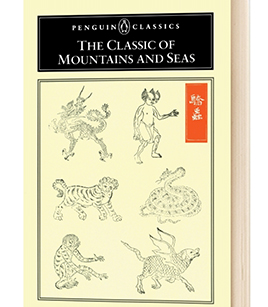‘The Classic of Mountains and Seas’

FILE PHOTO: The Classic of Mountains and Seas (English version) published by Penguin Random House
The Classic of Mountains and Seas is an encyclopedia of ancient China. Its rich content involves history, geography, ethnology, mythology, religion, zoology, phytology, mineralogy, and medicine, etc. The subject variety and the peculiarity of its content are remarkable among ancient Chinese books. The book is divided into 18 volumes, among which volumes One to Five are entitled The Five Treasures: The Classic of Mountains. Volumes Six to Eighteen are called The Classic of Seas. The Classic of Mountains mainly records mountains and rivers in ancient China. It depicts diverse subjects such as ancient history, plants, trees, animals, myths, and religion. The Classic of Seas records not only geographical locations, but also the physical features of foreign people in remote countries.
Opinions have been wildly divided on who the author was and when the book was written, as well as how the book should be categorized. Originally proposed to have been authored by such mythical figures as Yu the Great or Boyi, the consensus among modern scholars is that the book was not written at a single time by a single author, but rather by numerous people from the period of the Warring States (770–476 BCE) to the beginning of the Han Dynasty (202 BCE–220 CE).
During the Tang (618–907) and Song (960–1279) dynasties, the book was regarded as a book of geography. In the Ming (1368–1644) and Qing (1644–1911) dynasties, in light of a growing understanding of the world and other factors, The Classic of Mountains and Seas came under the scrutiny of literary criticism. Since the late Qing Dynasty, due to the introduction of Western anthropology and other disciplines, researchers have employed different approaches in the study of the text to identify the author, when the book was written, different editions, the creatures, figures mentioned in the book, geographical information, etc.
Edited by REN GUANHONG
